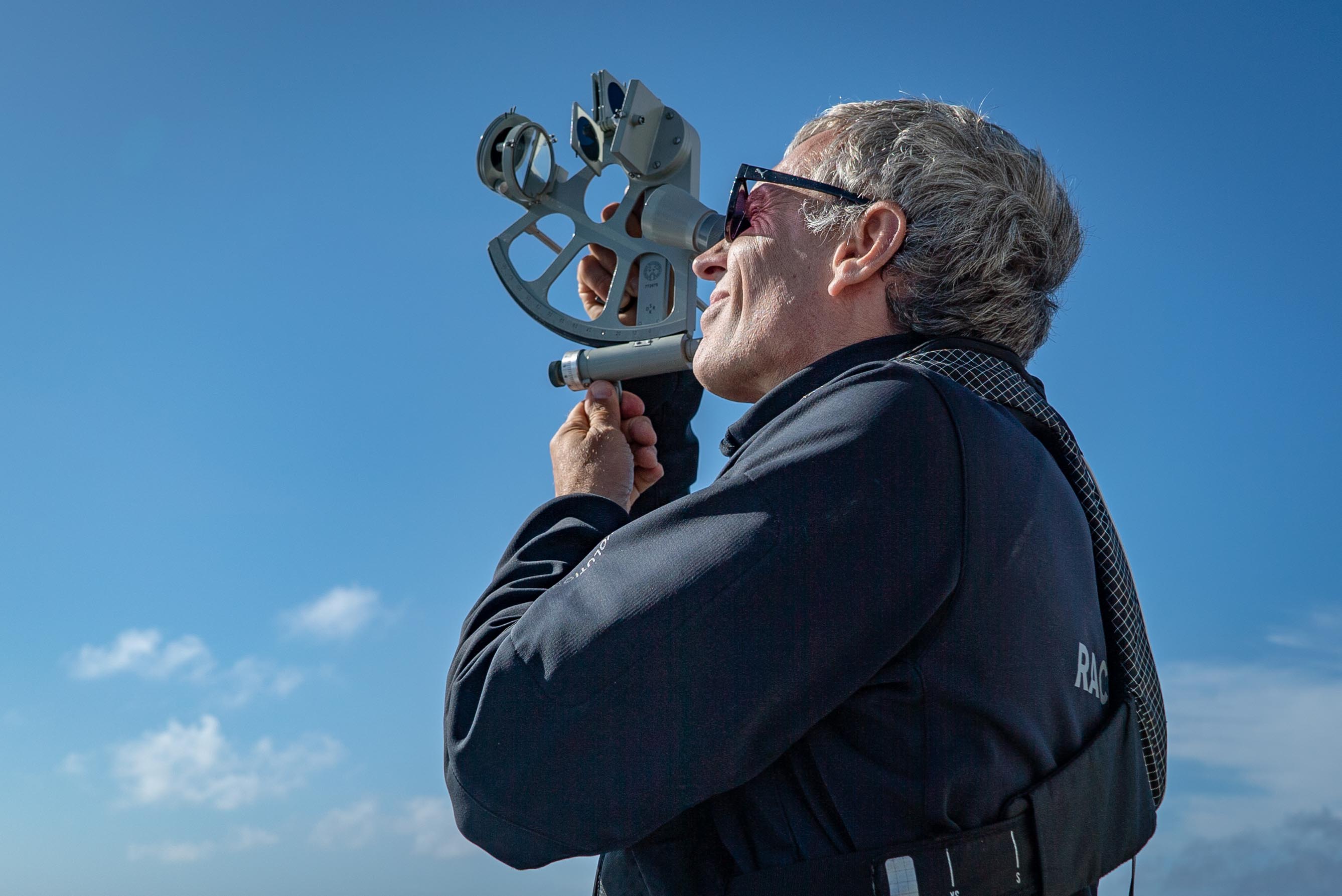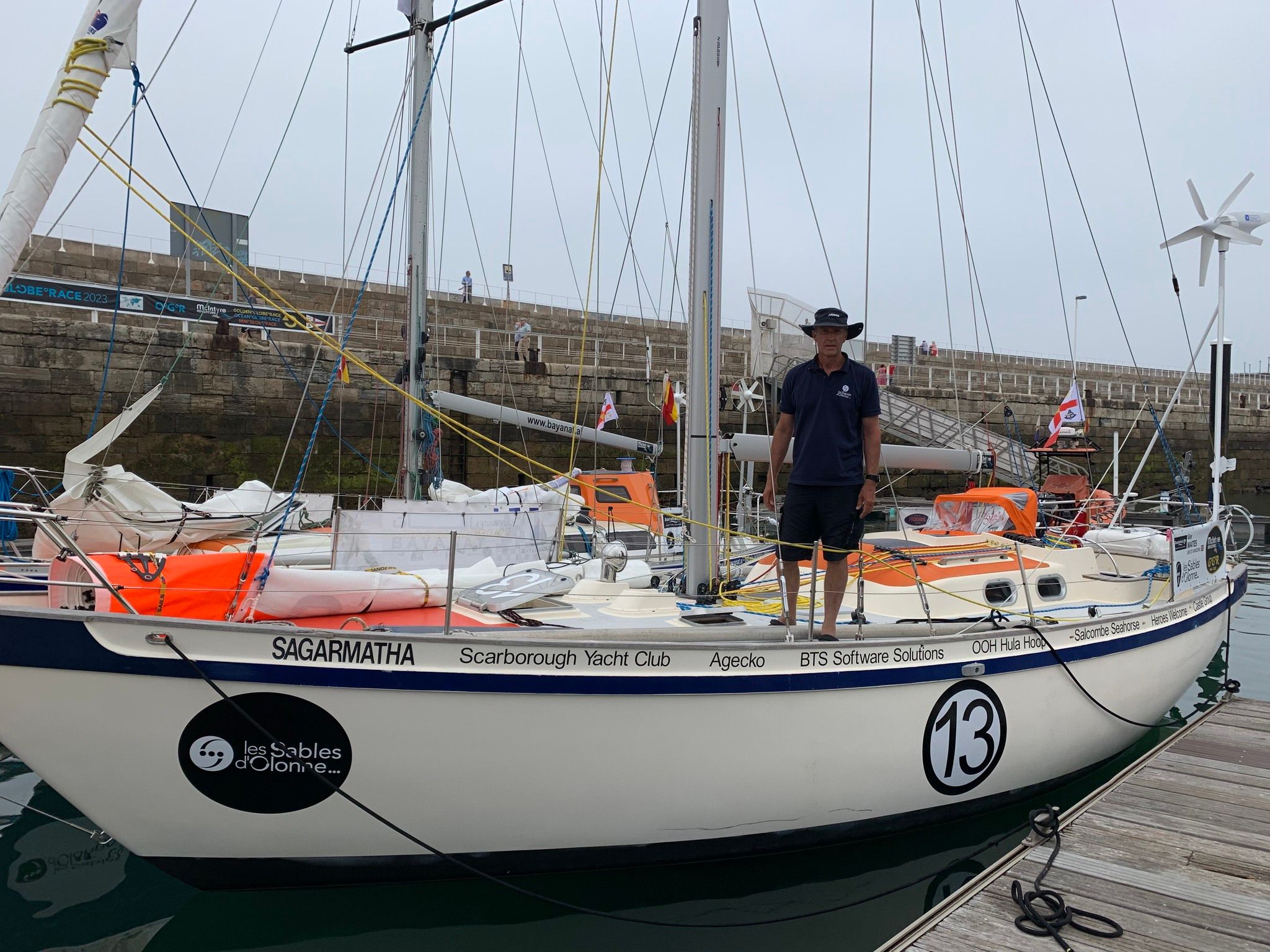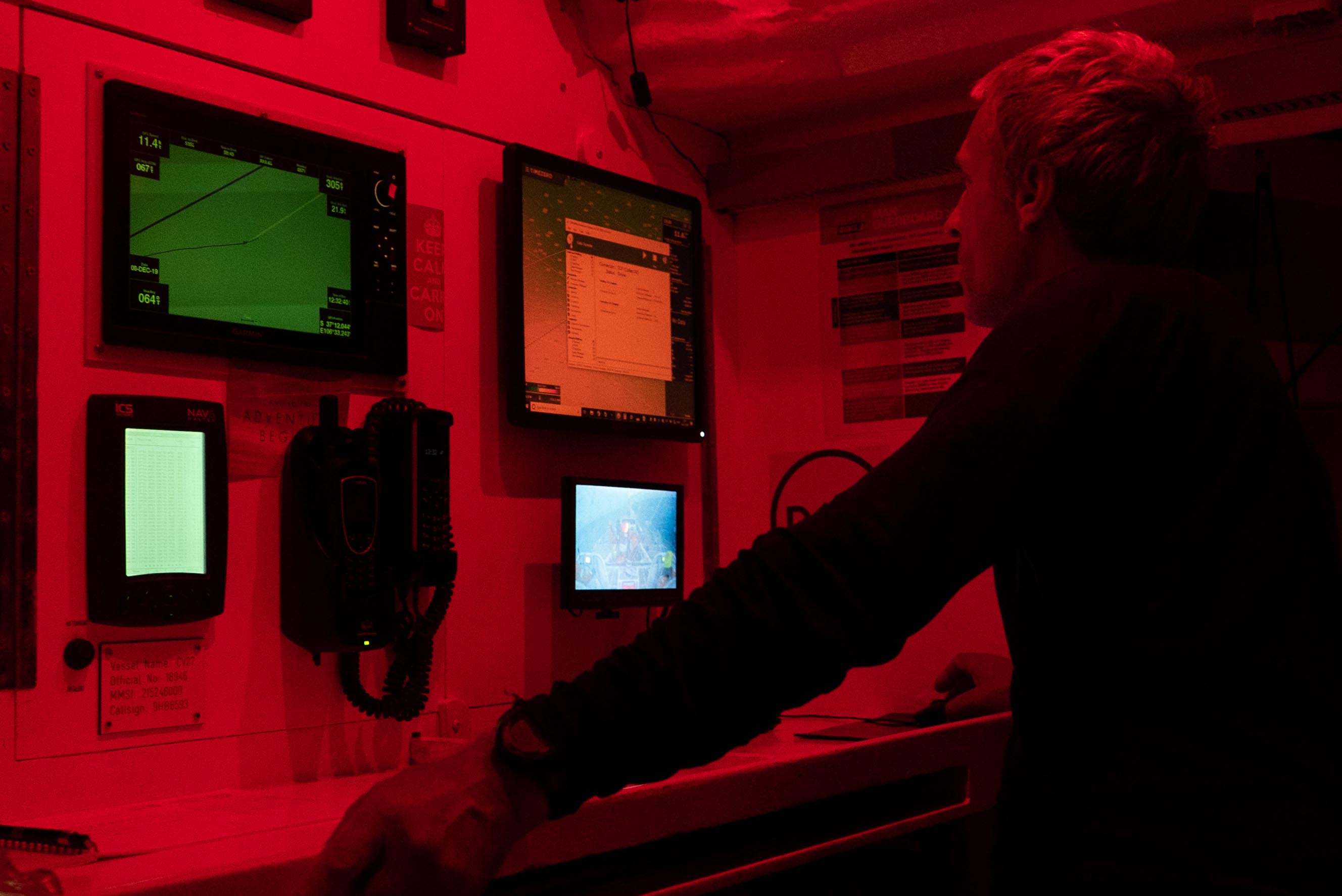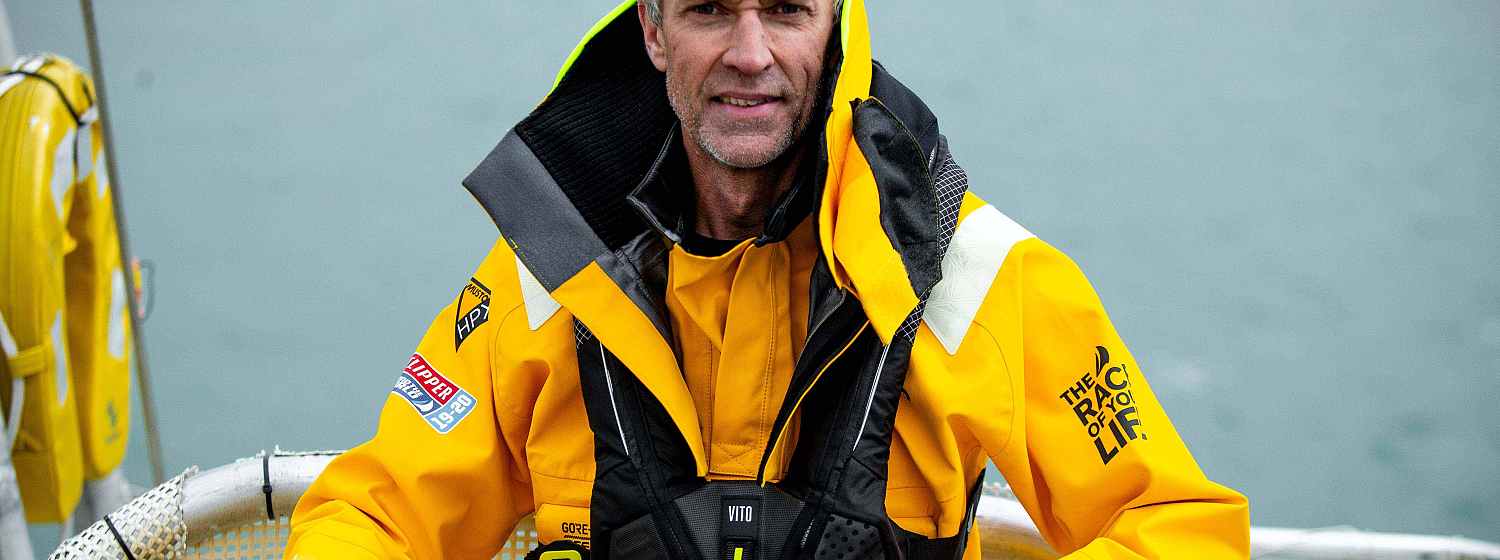Q&A: Former Clipper Race Skipper takes on Golden Globe Race
05 September 2022
Former Clipper Race Skipper Guy Waites is taking on one of the most remarkable sailing challenges on the planet - the Golden Globe Race.
It’s a challenge that is close to the heart of the Clipper Race. Its first edition propelled Founder and Chairman Sir Robin Knox-Johnston to fame when he was the only entrant to complete it in 1969. After winning the event he became the first person to sail solo, non-stop around the world.
Guy and his 16 fellow entrants are sailing without modern technology or the benefit of satellite-based navigation aids. Paying homage to the original race, the Golden Globe Race (GGR), which started on 4 September, limits its entrant to sailing similar yachts and using the equipment that was available to Sir Robin in that first race.
Before he set sail, we caught up with Guy in Les Sables d’Olonne, France, as he was making final preparations for the Golden Globe Race 2022

Guy puts a sextant into use whilst on the Clipper 2019-20 Race
How long have you been planning for the Golden Globe Race?
Well, it’s been in my mind for years and years, but the planning began back in 2019 but we didn’t get the boat until early 2020.
What makes it stand out from other round the world races?
The boats have to be relatively ordinary, fibreglass cruising boats that were designed before 1988. They have to be between 32 and 36ft long with a long keel. You’re not allowed any expensive, exotic materials like carbon fibre. It’s a back-to-basics race that’s trying to recreate 1968 as closely as possible.
What’s your sailing background? How did you get here today?
I started sailing 30 years ago and got into racing on keelboats initially. I gradually worked my way up and gained qualifications up to RYA Yachtmaster Offshore. I have always been fascinated by the solo races - the OSTAR, the Vendee… any transat! I followed them for years and years and knew one day I would like to do something like that. In 2010 I first bought my own boat and sailed it solo across the Atlantic in 2011. I’ve done the Atlantic five times now single handed.
Then in 2018, my wife Julie and I had been following the 2017-18 edition of the Clipper Race because Julie was due to take part in Leg 8. But I ended up joining the race myself as a First Mate (AQP). I joined in Airlie Beach, Australia (The Whitsundays stopover) and sailed all the way back to the finish! That encouraged me to apply to be a Clipper Race Skipper for the following edition and I was the skipper of the Dare To Lead team until the pandemic halted the race. That’s the point where I found my GGR boat, Sagarmatha, and started preparing her for this race now.
What is it about racing on your own that drives you to participate in events like this?
The first reason has nothing to do with sailing - even as a young child I would wander off on my own without a care in the world. My parents would have to search high and low for me - so I've always been very comfortable in my own skin.
It’s not that I don’t like the company of others - which is just as well when you’re a skipper of a Clipper 70 with 20 crew members on board - but I am very happy in my own skin. It doesn't bother me that I'm alone - I enjoy the refinement of skills to manage the challenge. That is the draw for me.
What prep have you done ahead of the GGR?
Sagarmatha was stuck in Panama with the borders closed so I spent the first seven months of lockdown at home thinking about all the things I was going to be doing - I wrote lots of lists and sourced some of the traditional sailing equipment that we needed in order to comply with this race.
Eventually I arrived in Panama to get my hands on the boat and sailed the Caribbean Sea and the Atlantic as part of the qualifying process. I learnt as much about the boat as I could.
Having sailed the Southern Ocean with the Clipper Race, I’m fully aware of what that’s like and I’m now doing it on a boat half the size and I’m on my own. It’s not like double whammy, it’s like quadruple whammy!
What challenges did you have on that trip?
It was the first time that I had sailed Sagarmatha, I was on my own and sailing the Atlantic in the winter months which isn’t ideal. About 80 miles from the Azores we ran into an easterly storm and I had to turn back towards the USA for a few days when we were knocked down and damaged the mast - which I knew was weak as it was the original from 1993. So it was a challenge just to get the boat back let alone get the funds to get the boat ready and be here to race.
What mental skills have you gained to keep calm in those situations?
There is nothing you can do about bad weather. When it comes, it comes. You live very much in the moment. You can have all the planning and preparation in the world but you don’t know when it will happen or what will happen when it arrives - you have to deal with it the best you can at the time and protect yourself so you are physically and mentally in the best position you can be. It’s like meditation! You have to be on top of your own mental wellbeing.

Guy on board Sagarmatha
Tell us about Sagarmatha?
It was John Rock’s original boat - the designer of the Tradewind 35. It was then sold to a British company who sailed her all the way to New Zealand. They then sold it to Don McIntyre, Founder and Race Chairman of the Golden Globe Race who intended to enter the then named yacht, Silver Heels, into the GGR. The yacht was then sold to Kevin Fairbrother who entered the race (GGR) in 2018. The reason the yacht is now called Sagarmartha is the Nepalese name for Mount Everest and Kevin has climbed Mount Everest four times - Julie and I like the name so we kept it. I even kept the race number - 13 - I’m not superstitious!
What will GGR be checking before you leave?
GGR inspects the boats for the green card which is essentially your green light to take part in the race. They go through all the qualifying items for the race - not just the equipment but the structure of the boat too. The safety kit on board, making sure you have the right EPIRBS, sat phones, searchlights, VHFs - the list goes on! Although the race isn't externally regulated, the FFV who oversee the Vendee Globe race had a look over the race rules in 2018 and said it was the highest level of safety specification that they have ever seen for any race. It's very intense, time consuming and costly, but it’s all for our safety.
What route will you take?
It’s the classic Clipper Race route - down south towards Brazil, then over towards South Africa for a media drop, over to Australia and to Hobart - for a media drop. Then we are going under Cape Horn - another media drop in Punta del Este, Uruguay, and then back over the equator and back to Les Sables d’Olonne.
The media drop points are designed to hand over cassette recordings and media we make en route - it's all done on old equipment to recreate the original race so it will be a chance to hand that over. A support boat will be doing Facebook Lives when we get to those points.
What equipment is on board?
HF radio and VHF radio on board - that’s what was available in the late 1960s. We do have sat phones but we can only speak to the medical team if we need it, or race office. We have trackers so you can see where we are. But none of the tech on board benefits us sailing-wise. There's some equipment that would relegate me to the Chichester class if I needed to use it - two handheld waterproof GPS positioning systems, a jerry can of emergency water, a desalinator, or any stops anywhere would also relegate me.
How will you get water?
The only way worth talking about, is to collect it from the mainsail. I don’t think you’ll find anyone has their mainsails branded with any sponsor logos because the water would run off the dye and into your drinking water.
But I have no intention of running out in the first place - I’m taking quite a bit.
Tell us about what food prep you’ve done?
My food is split between freeze dried and tinned. The freeze dried is light and takes up little space but needs water to rehydrate it so you’re literally eating into your water supply. The plus of the canned food is that it doesn't need rehydrating and the water is drinkable. It’s all one pot cooking, I have a single burner stove. I just eat it out of the pan.
Any treats?
My sister Heather has baked fruit cakes using our mother’s recipe. That’s been a tradition for some time - she did some for the Dare To Lead team, too. So I have that on board. A former Dare To Lead crew member, Theresia Cadwallader, has baked her flapjacks - I’ve got a big box of those. But otherwise there’s not so many sugary treats.

No high tech chart plotters will be available for Guy use on the GGR22
Which pieces of traditional kit are you looking forward to using, and which modern gadgets will you miss most?
I’ll answer the last bit first - a chart plotter! We are all used to looking at the LCD screen and knowing where we are 24/7.
I’m looking forward to using the sextant - it’s not just a necessity but a good friend. I have a spare one just in case.
What have you got with you for entertainment?
There will be plenty to think about just sailing! I’m not taking a cassette player but I have a shortwave radio, and the variety on that as we go around the world will be far greater than any cassette.
The only books I have are for navigation. There will be plenty to do.
Who is your support team?
My wife, Julie, is my team manager. She has been a huge support. I’ll have been away for the best part of the year in total. Scarborough Yacht Club has also been amazing in helping me. I sold my house to get to the start line - and that still wasn’t enough! So I’m grateful for all of my sponsors who have got me here, too.
There’s some former Clipper Race crew who have come out here to support too, which is great to have. The Clipper Race family is extensive and it’s great - they’ve also been so supportive in helping financially, too. It wouldn’t happen without them.
How are you feeling now?
I think you can be ready for too long - the boat will never be ready! But no, it’s coming together, I’ve been getting some down time to spend with friends and family too.
How can we follow you?
The home for everything is the GGR website and social channels. You’ll get links to live streams, and constant position reports every 4 hours. There will also be the satellite phone calls and twitter messages we will send.
And a question from Sir Robin himself
What have you learnt from the Clipper Race that will assist you for the GGR?
The experience of the Southern Ocean has been invaluable. Also, the temperature of the air changes the way the wind fills the sails. I’ve not experienced that anywhere else in the world and I wouldn’t have that if it wasn’t for Clipper Race.
Best of luck from everyone at Clipper Race - we will all be following Guy closely as he embarks on the remarkable Golden Globe Race.
To hear the full interview with Guy, listen below.
Join The Race